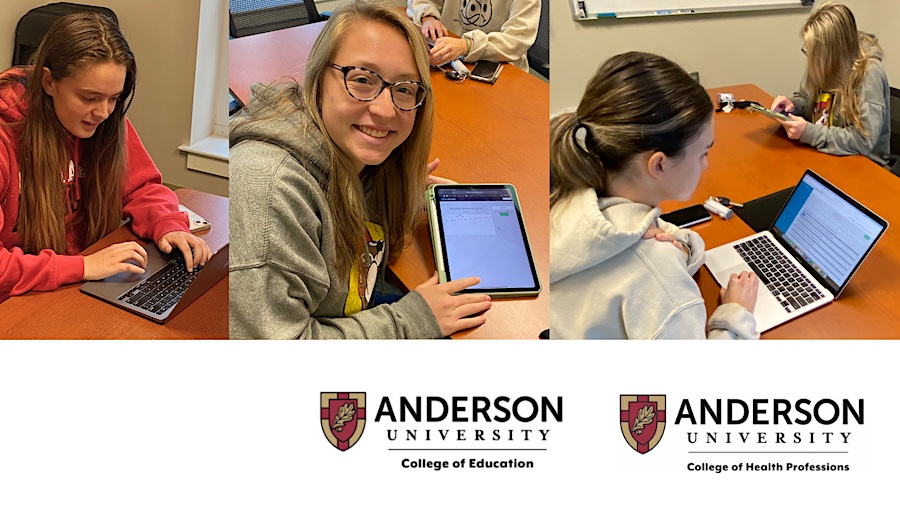Test taking can be daunting for even the brightest of students. For some, certain words can be roadblocks.
That’s why software is being developed to help them and their instructors determine how they are progressing in their knowledge of the vocabulary essential to their content area.
Dr. Joanna Stegall, department chair of educational specialties in the Anderson University College of Education, has long recognized that the knowledge of content-specific vocabulary is an important key to students mastering the content provided through lectures, labs, projects and readings; but as far as assessing student progress, there just wasn’t an app for that.
The positive correlation between content knowledge and vocabulary in prior peer-reviewed studies led Dr. Stegall to her doctoral research, studying the relationship between vocabulary knowledge and students’ grades in high school algebra. As their vocabulary knowledge increased, so did their abilities to correctly solve equations. To earn a high school diploma, students must earn an Algebra 1 credit, but some students, especially those with learning disabilities, and/or are at-risk, struggle to pass.
“I started investigating the relationship of content-specific vocabulary and students’ ability to be successful in their coursework. My area of specialization is interventions for students with learning disabilities (LD), and there was a sparsity of peer-reviewed research conducted on this topic. Students with LD typically have vocabulary knowledge that is weaker than their peers and have high rates of failure in Algebra I, so I wanted to know if these two appeared connected,” Dr. Stegall said.
Curriculum-based measurements (CBM) are brief, formative and frequent assessments used to provide student data across the length of the course. As the student learns more content, the CBM scores should increase. By the end of the course, a previously set CBM goal should be met. In research studies, teachers who use CBM data for making instructional decisions have greater gains in students’ performance than teachers who do not since they have an easy way to identify which students are not adequately progressing. In higher education, there are also students who struggle to pass courses that are heavy in content-specific vocabulary. Dr. Stegall wondered if such measurements could enable professors in determining earlier in a course which of their students weren’t making adequate progress; so that the professors could provide early and ongoing support to these students. This could be especially helpful for students taking courses but have insufficient background knowledge.
“They could give a quick assessment (5 minutes) each week—but the thing is—I wanted to put it on an app, because scoring these with paper and pencil, which is the only way this type of CBM, vocabulary matching measures (VMM), had been researched and was laborious for the instructors,” Dr. Stegall said. “It would be hard to keep up with scoring and graphing the weekly VMM in order to determine which students are not making adequate progress.”
Even 12 years ago, as she was doing her dissertation research, Dr. Stegall knew that a computer-based solution could streamline the process and take away cumbersome paperwork. The idea was a dream of hers, but she needed to team up with someone who could turn that idea into a digital solution.
Dr. Stegall reached out to Greg Newcom, who is the CEO of an educational technology company. Newcom agreed to work on the application as research and development for a potential product. Newcom began to storyboard what the user experience would look like for the professor and the student.
“I have a technical background, so I was responsible for designing the underlying database, the data model for it, and then from that the development team took that and then built the user experience on top of it,” Newcom said. “It was an R&D effort that we invested to build the prototype because we see the value in that and the opportunity to productize it and bring it to market is the bigger picture, long-term.”
The application provides “just in time” data the professor can use to determine areas where their students need assistance.
“If you would expect by the end of the course they should know 90 percent of their definitions, then you can set their goal line at that,” Dr. Stegall said.
Dr. Stegall and Newcom hold the license for the technology and a prototype is being researched in the School of Nursing at the Anderson University College of Health Professions. Testing is being done in collaboration with Dr. Marie Amma, senior lecturer of undergraduate nursing. Dr. Amma is already seeing positive results from the app’s pilot program.
“This is the second semester I’ve used the prototype and we were very excited about semester one results,” Dr. Amma said. “The students have a lot of prerequisite courses, and there are a lot of sciences that deal in nursing, but there’s a pathophysiology where there’s a lot of vocabulary that they’re not going to really get anywhere unless they’ve had a previous pathophysiology course which most of them haven’t. So there’s a huge learning curve there.”
Dr. Amma is excited to have this tool at her disposal, and hopes that it will help the School of Nursing retain talented students and keep them from falling through the cracks because of misunderstood and unknown terminology.
“Building out something like this that can bring that kind of value and help identify early students at risk, so that teachers can then intervene appropriately can potentially have an impact on a student’s life ultimately,” Newcom said.
The next step is to develop a finished product that can be marketed and licensed both in higher education and K12 schools, according to Newcom.

